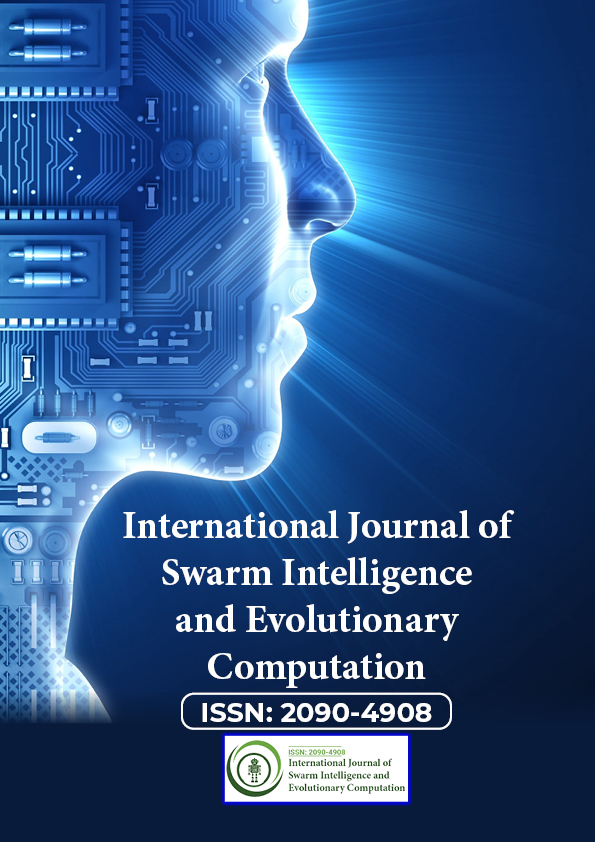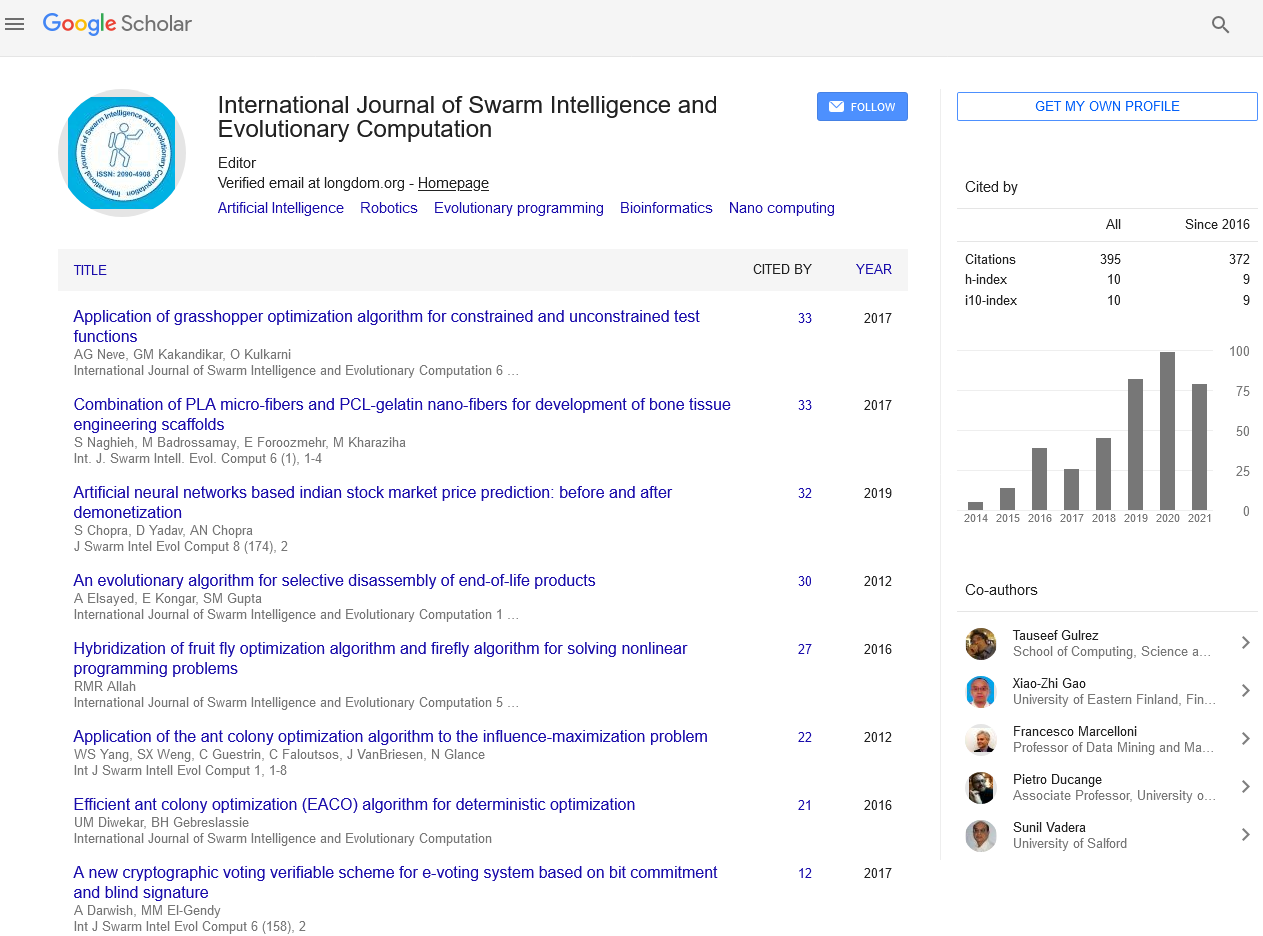Indexed In
- Genamics JournalSeek
- RefSeek
- Hamdard University
- EBSCO A-Z
- OCLC- WorldCat
- Publons
- Euro Pub
- Google Scholar
Useful Links
Share This Page
Journal Flyer

Open Access Journals
- Agri and Aquaculture
- Biochemistry
- Bioinformatics & Systems Biology
- Business & Management
- Chemistry
- Clinical Sciences
- Engineering
- Food & Nutrition
- General Science
- Genetics & Molecular Biology
- Immunology & Microbiology
- Medical Sciences
- Neuroscience & Psychology
- Nursing & Health Care
- Pharmaceutical Sciences
Perspective - (2022) Volume 11, Issue 7
Scientific Implications of Swarm Robotics
Brendon Williams*Received: 16-Jul-2022, Manuscript No. SIEC-22-17824; Editor assigned: 18-Jul-2022, Pre QC No. SIEC-22-17824(PQ); Reviewed: 05-Aug-2022, QC No. SIEC-22-17824; Revised: 16-Aug-2022, Manuscript No. SIEC-22-17824(R); Published: 26-Aug-2022, DOI: 10.35248/2090-4908.22.11.262
Description
Swarm robotics is the employment of a large number of autonomous robotics to complete a task. Decentralized robot swarms coordinate the behaviors of a large number of very simple robots. Swarm robotics is crucial in the development of collaborative Artificial Intelligence (AI). Robot swarms are now used in search and rescue, precision agriculture, Supply Chain Management (SCM), and military reconnaissance.
Swarm robots seek to mimic how social creatures, such as insects, use collaborative behaviors to accomplish complex tasks that are beyond the capability of single person. Swarm robotics researchers, for example, might investigate how bees use pheromones to map geographical areas. The researchers might then utilize the bee's algorithms to mimic the same behavior in robots.
Design
A robot swarm's design is a tough task and the requirements are typically defined at the collective level, but the designer must define hardware and behavior at the individual robot level. The generated robots should interact in such a way that the swarm's overall behavior fits the desired criteria. There are two approaches to the design challenge in swarm robotics: manual design and automatic design.
Manual design involves the designer going through a trial-anderror process in which the individual robot's actions are designed, tested, and improved until the desired collective behavior is reached. The probabilistic finite state machine is the most often used software architecture in swarm robotics. Several collective behaviors, such as aggregation and chain formation, have been obtained using probabilistic finite state machines. Another popular approach is virtual physics. In this approach, robots and their surroundings interact via virtual forces. This method is very well suited for spatially organizing collective activities like pattern generation and collective mobility. The fundamental limitation of manual design at the moment is that it is entirely dependent on the originality and ability of the human designer: building a robot swarm is more of an art than a science. Despite a few preliminary attempts, a systematic and universal approach to designing robot swarms remains lacking.
Automatic design in swarm robotics has primarily been done utilizing the evolutionary robotics technique. Individual robots are often controlled by a neural network whose parameters are determined by artificial evolution. Evolutionary robotics has been used to produce a variety of collective behaviors, including collective transportation and communication network creation. One of the major limitations of evolutionary robotics is that defining an appropriate evolutionary context is frequently complex and time consuming.
Analysis
Models are typically used in the analysis of a robot swarm. A model of a robot swarm can be realised at two levels: the microscopic level, which models the individual robots' behaviors, and the macroscopic level, which models the swarm's collective behavior.
At the microscopic level, modeling entails creating a comprehensive representation of each individual robot in the swarm. Unfortunately, due to the enormous number of robots involved, microscopic modeling is difficult. Microscopic modeling frequently relies on computer-based simulations. By focusing on the collective behavior of the swarm, macroscopic models sidestep the complexity and scalability challenges associated with modeling each individual robot. The use of rate or differential equations is one of the most frequent macroscopic modeling methodologies. Rate equations represent the time evolution of the ratio of robots in a specified state, i.e., robots executing a specific action or in a specific area of the environment.
Conclusion
Swarm robots have yet to be utilized for tackling real-world issues, despite its potential to enhance robustness, scalability, and flexibility. Swarm robotics systems are not widely used in the real world due to a variety of constraints. More research on robotic hardware is required to overcome hardware flaws that limit the functioning of present robotic systems, while more research on behavioral control is required to identify effective techniques to allow a human operator to engage with a robot swarm. More effort is needed to offer convincing case studies, particularly in outdoor applications, as well as to establish business cases and economic models that demonstrate how and where swarm robotics might be more effective than alternative approaches.
Citation: Williams B (2022) Scientific Implications of Swarm Robotics. Int J Swarm Evol Comput. 11:262.
Copyright: © 2022 Wang E. This is an open-access article distributed under the terms of the Creative Commons Attribution License, which permits unrestricted use, distribution, and reproduction in any medium, provided the original author and source are credited.


